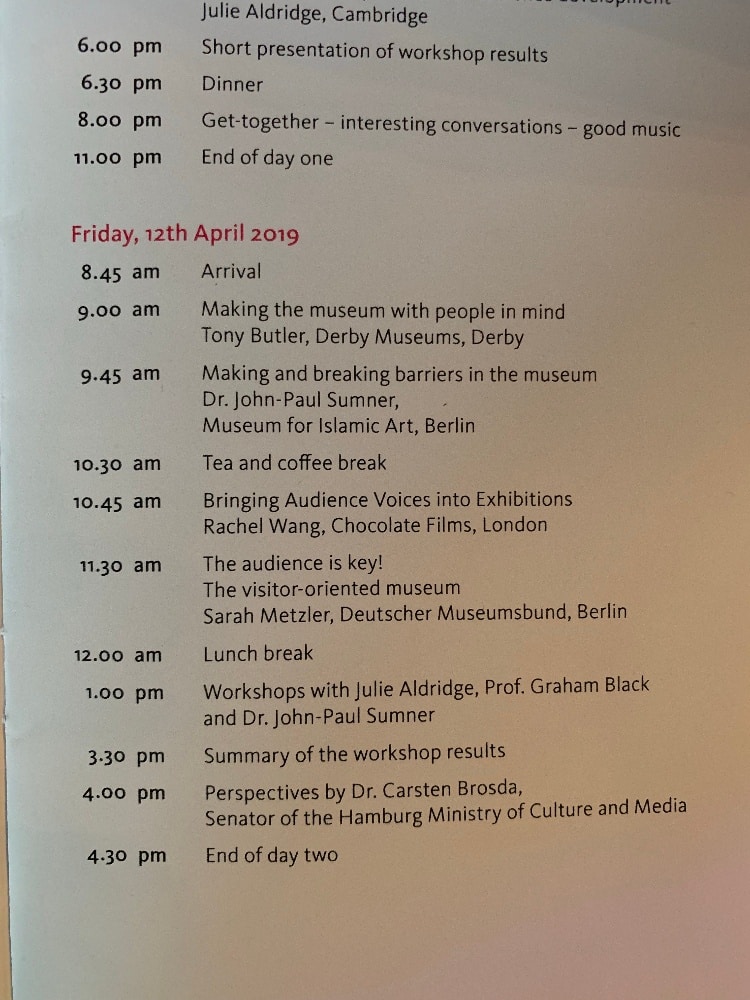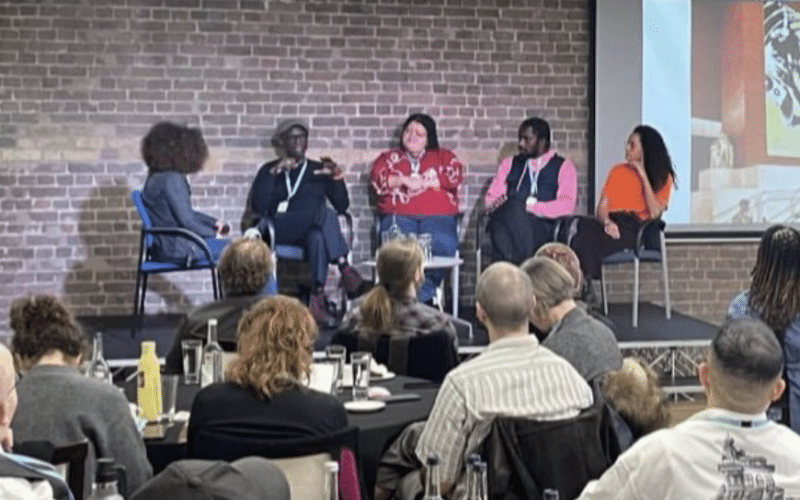Chocolate Films Director Rachel Wang travelled to Hamburg (Germany) as a speaker at the Relevant Museum conference 11-12 April 2019. The event, hosted by the Ministry of Culture and Media Hamburg and supported by NORDMETALL-Stiftung, saw over 80 German museum professionals and expert speakers from the UK come together to discover industry innovations and how to increase audience engagement.
We were delighted to be invited to the conference, to meet so many interesting people and organisations – with close to 2 million inhabitants, Hamburg has over 50 museums! – and to share how video content can contribute to Bringing Audience Voices Into Exhibitions.


Video can be a fantastic tool to include the voices of the wider public, diverse communities and targeted groups of people, into exhibitions. It can give the audience more ownership of and involvement in the exhibition itself. It can also expand the perspectives revealed in the exhibition.
See our video production services for the Arts & Culture sectors
A specifically interesting type of content to include the public’s voice in an exhibition is video that is co-created with audiences and community groups. We are passionate about this at Chocolate Films and want to share some hopefully inspiring examples, as Rachel did at the Relevant Museum conference in Hamburg:
1. HEADSTONE MANOR
Headstone Manor is a local museum that recounts the story of the Manor House and the history of Harrow in North London. From 2014, it underwent a large-scale transformation. We were commissioned to create over 50 pieces of AV content for the site, shown there from its grand reopening in 2017. Most significant is the film that introduces the museum and the place – Headstone Manor.


The film needed to be a 6 minute whip through thousands of years of Harrow’s local history, from the Stone Age to the present day, and the brief stipulated that it would require ‘dramatic reconstructions’ of past events.
Since this is a museum that is right at the heart of the community, we tried to think not only of how the content would reach the audience, but also if there were any ways of engaging the audience in the production of the film. We proposed that the past events should be re-enacted by members of the current, local community. And that we should cast it colour-blind, reflecting the current cultural make-up of Harrow, which is the most diverse borough in London.
The film was largely shot on green screen, and features scenes from the Stone Age, the Roman Empire, Henry VIII’s reign, and the impact of the Industrial Revolution. At the end the film reaches present day, where you see all of the members of the cast in their regular clothes, as opposed to Roman, Tudor or Victorian dress.


So many people were keen to be involved and this generated a wonderful buzz in the run-up to the opening. The final 6 minute film itself has a warmth and sense of community, that would be missing if we had just cast through classic routes.
It should be said, that this was not done as a money-saving trick. We paid the community actors a fee for their work, and the casting and cast management was far more labour intensive than it would have been with professional actors. This was a complex film to produce, but the integrity of the content and the quality of the film were never threatened by shooting in this way.
The long-term impact is that members of the local community feel ownership of the film and consequently a greater bond to their local museum, Headstone Manor.
2. IMPERIAL WAR MUSEUM
At the Imperial War Museum London, a special Gallery tells the story of the First World War. It has state-of-the-art digital interactive and AV content. Alongside this, there are 22 short silent animations made by children and young people in London.
We were invited to work with the IWM’s learning department over two years, to run video animation workshops with schools across the city. The aim of the programme was to teach some of the lesser known stories of the First World War to local children and young people, including ‘The War In Africa and India’ and the impact of the war on medical and mental health treatments. It was a complex and challenging project all round. But because the brief and the support from the museum were so strong, especially with regards to sourcing information and ensuring historical accuracy, these films now sit alongside high-spec professionally created content in this major permanent exhibition. The work is surprising and continuously gets positive feedback.
What is fascinating about this project, is that the ideas and discussions that went into producing these animations give a completely fresh and new perspective to the history being told. The approaches, playfulness and freedom that the young people brought to the films was really magical. The icing on the cake was that this project won Educational Initiative of the Year 2015 (UK) at the Museums + Heritage Awards.
3. INTERNATIONALES MARITIMES MUSEUM HAMBURG
In Hamburg, we have developed a strong relationship with the Kinderkulturbüro. This has generated co-created work: for the past 6 years we have been training young people in stop-motion animation and working closely with museums to create content in response to exhibitions.
At the International Maritime Museum – Internationales Maritimes Museum Hamburg there is a film made by 20 young people, aged 13 to 14, from the local school Wilhelm-Gymnasium in collaboration with the Kinderkulturbüro and Chocolate Films Workshops.

Before the workshop, we worked closely with two German animators to devise the narrative and make sure we got all the historical facts right. One of our animators went to Hamburg and ran the 3-day workshop with the young people.
The end result is a delightful short film that tells the story of 50 years of container shipping in Hamburg. Celebrating one of the world’s busiest ports, this film looks at the changes that have occurred over the last five decades.
4. DEUTSCHES SCHIFFAHRTSMUSEUM
A previous project produced in a similar way with the Kinderkulturbüro and the German Maritime Museum – Deutsches Schiffahrtsmuseum, Bremerhaven was about the discovery of a medieval merchant ship from Bremen.
The Museum was very involved throughout. They worked closely with us to create a script and storyboard for the animation video, to ensure it is historically correct. ‘Die Bremer Kogge’ was created with 18 young people aged 12, over 5 days of workshops:
The Kinderkulturbüro submitted the film to the ‘Kid Witness News Global Contest 2018’ organised by Panasonic. Two of the young creators went along to the awards ceremony in Tokyo, Japan and were absolutely thrilled to take back the 1st prize with them to Bremerhaven. ‘Die Bremer Kogge’ is now touring the Northern towns in Germany, featuring at the Europäisches Hansemuseum in Lübeck and Internationales Maritimes Museum Hamburg in Hamburg amongst others.
{{cta(‘a33b46e7-70d1-4127-90dd-06ea2ccb51aa’,’justifyleft’)}}
5. Horniman Museum and Gardens
All previous examples of co-created exhibition videos look at ways of working with audiences to reinterpret historical stories. So, what about bringing the audiences’ own stories to life?
This is something that we have recently done with The Horniman Museum and Gardens in South London. They opened the World Gallery, a high-profile permanent exhibition that celebrates human creativity, imagination and adaptability. Within the exhibition are over 3,000 objects from the Horniman’s internationally important anthropology collection. And when you arrive there, the first thing you see is a 10 minute film where people from the local community present objects that mean a lot to them and explain their significance:
It’s a beautiful and touching introduction to the themes and vision for the World Gallery, presented by its visitors. But this film’s engagement was even deeper than that – it was actually made by members of the community. Chocolate Films ran a two-week summer project teaching local young people the skills they needed to create this film and then we supervised the shoot.
The Museum actively chose to put community-focused content at the front of their showcase gallery. This makes a clear statement about how important their audience is to the Horniman. Just last month, the World Gallery was nominated as Permanent Exhibition of the Year (UK) at the Museums + Heritage Awards.
6. Museum of London
In the final two film projects presented here, the people we co-created the content with, are also the subject of the exhibition. This is a third and deepest type of engagement.
The Museum of London is one of the most innovative museums in the city. Over the last few years, they have very much embraced the idea of being a museum of Londoners, giving importance to the people who live in the city now.
In this context, films about contemporary life emerge that bring together exhibition videography and social documentary. Chocolate Films worked with one of the Museum of London curators, Jen Kavanagh, on two exhibitions. One was about the London’s tattoo parlours and the other celebrated the 40th anniversary of the era of punk, telling the story of punks in the city.


For Punks, it would have been quite straightforward to revisit the stories of punk musicians, fashion designers and filmmakers. But instead the museum chose to invite into the museum anyone who identified as a punk from the 1970s, to record an oral history. We worked with a selection of those punks to produce a large-scale installation, two documentaries and an exhibition trailer for the Museum of London Punks exhibition.
What makes this project unique and different? It is a major exhibition that was entirely sourced through the Museum audience and wider public. The images, artefacts and stories offered a new, fresh perspective on a part of London history that’s been told so many times over the decades.
See more Arts & Culture Documentaries
7. National Portrait Gallery
Finally, just last year, we worked with the National Portrait Gallery in London to create a display to celebrate its members.
The National Portrait Gallery runs a successful membership scheme. 2018-2019 is its 20th anniversary, and they wanted to do something special to commemorate this. We talked through a range of ideas and came up with something simple yet very effective: an exhibition of photographic portraits of members, shot in their favourite areas of the gallery.
The Gallery commissioned young photographer Tereza Červeňová, who had recently completed a commission for them of the actor Jack O’Connell, and ran a competition asking members to explain what makes the NPG special to them. Six members won the prize of being featured in the exhibition.
Tereza shot beautiful photographs of the winners, and we worked with them to produce six video portraits. These went on display along with a 3-minute film giving visitors an overview of the competition and the creative process. The portraits were also used on the National Portrait Gallery website and social media where they gained 10.000s of views. Celebrating the audience in this way was a new thing for the Gallery, with a warm and engaging result.
{{cta(‘4d9dee85-9d22-4dcc-aafd-8e0e4920ca50’)}}
Three key takeaways about video content co-created with audiences and how this can benefit your museum or gallery:
-
Co-created content opens the way to a more diverse authorship of exhibitions, enriching the display with different, inspiring perspectives.
- It attracts new and diverse audiences into the museum.
-
It increases audience engagement and can foster a sense of belonging and relationship with the museum for the local community.










